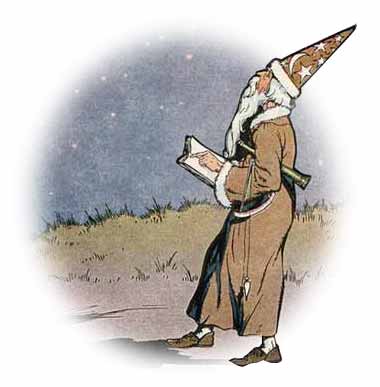The Astrologer 占星家 (精美插图) 双语 拼音注音 伊索寓言
标签:伊索寓言 儿童故事集 中英对照翻译 双语故事 拼音注音
Last Update 最后更新: 2022-01-12

The Astrologer (English)
Total Words: 203
A man who lived a long time ago believed that he could read the future in the stars. He called himself an Astrologer, and spent his time at night gazing at the sky.
One evening he was walking along the open road outside the village. His eyes were fixed on the stars. He thought he saw there that the end of the world was at hand, when all at once, down he went into a hole full of mud and water.
There he stood up to his ears, in the muddy water, and madly clawing at the slippery sides of the hole in his effort to climb out.
His cries for help soon brought the villagers running. As they pulled him out of the mud, one of them said:
"You pretend to read the future in the stars, and yet you fail to see what is at your feet! This may teach you to pay more attention to what is right in front of you, and let the future take care of itself."
"What use is it," said another, "to read the stars, when you can't see what's right here on the earth?"
Moral: Take care of the little things and the big things will take care of themselves.
占星家 (中文翻译 拼音注音)
很久很久以前,有个人相信自己能够通过解读星象来预知未来。 他自称为占星家,常常在夜晚凝视星空。
有一天晚上,当他正在村外一条宽阔的马路上散步。 他的双眼就盯着满天星斗。 他觉得自己看到了世界末日已近在咫尺,突然间,他掉进了一个满是淤泥和水的深坑中。
他站在浑水中,很紧张,用双手疯狂刨着滑溜溜的坑壁,想尽力爬出去。
村民们听到他的求救声便很快闻讯赶来。当把他救出来的时候,一个村民说道:
“你自以为能在星云变幻中预言未来,可是你却看不见自己脚下面都有些什么!希望这个教训能让你更加关注摆在你眼前的事,未来的事情就不用你操心了。”
“你连地面上有什么东西都看不到,”另一个说道,“看懂了星辰,又有什么用呢?”
About 关于
The Aesop Fables for Children 伊索寓言儿童故事全集 (图文英汉双语版) (this work), the english fables originally from The Aesop for Children: with Pictures by Milo Winter published by Rand, McNally & Co in 1919. Some of pictures come from Library of Congress. This work is considered to be in the public domain in the United States. The Aesop Fables for Children contains the text of selected fables, color pictures, video, and interactive animations, and will be enjoyed by readers of any age.
The Aesop Fables for Children are a collection of stories designed to teach moral lessons credited to Aesop, a Greek slave and story-teller thought to have lived between 620 and 560 BCE.
Aesop's fables are some of the most well known in the world and have been translated in multiple languages and become popular in dozens of cultures through the course of five centuries. They have been told and retold in a variety of media, from oral tradition to written storybooks to stage, film and animated cartoon versions—even in architecture. This page include translation to Simplified Chinese.
伊索寓言是一部世界上最早的寓言故事集,是世界文学史上流传最广的寓言故事之一。 本文包含伊索寓言故事英文原文和简体中文翻译(中英双语)。




